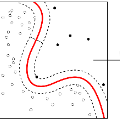We propose a simple and application-friendly network (called SimpleNet) for detecting and localizing anomalies. SimpleNet consists of four components: (1) a pre-trained Feature Extractor that generates local features, (2) a shallow Feature Adapter that transfers local features towards target domain, (3) a simple Anomaly Feature Generator that counterfeits anomaly features by adding Gaussian noise to normal features, and (4) a binary Anomaly Discriminator that distinguishes anomaly features from normal features. During inference, the Anomaly Feature Generator would be discarded. Our approach is based on three intuitions. First, transforming pre-trained features to target-oriented features helps avoid domain bias. Second, generating synthetic anomalies in feature space is more effective, as defects may not have much commonality in the image space. Third, a simple discriminator is much efficient and practical. In spite of simplicity, SimpleNet outperforms previous methods quantitatively and qualitatively. On the MVTec AD benchmark, SimpleNet achieves an anomaly detection AUROC of 99.6%, reducing the error by 55.5% compared to the next best performing model. Furthermore, SimpleNet is faster than existing methods, with a high frame rate of 77 FPS on a 3080ti GPU. Additionally, SimpleNet demonstrates significant improvements in performance on the One-Class Novelty Detection task. Code: https://github.com/DonaldRR/SimpleNet.
翻译:我们提出了一种简单且适用的网络(称为SimpleNet)用于检测和定位异常。SimpleNet由四个组件组成:(1)一个预训练的特征提取器,用于生成局部特征,(2)一个浅层特征适配器,将局部特征转移到目标域,(3)一个简单的异常特征生成器,通过向正常特征添加高斯噪声来伪造异常特征,和(4)一个二进制异常鉴别器,区分异常特征和正常特征。在推理期间,异常特征发生器将被丢弃。我们的方法基于三个直觉。首先,将预训练的特征转换为面向目标的特征有助于避免域偏差。其次,在特征空间中生成合成异常更有效,因为缺陷在图像空间中可能没有太多的共同之处。第三,一个简单的鉴别器更有效率和实用。尽管简单,SimpleNet在定量和定性上都优于以前的方法。在MVTec AD基准测试中,SimpleNet实现了99.6%的异常检测AUROC,与下一个表现最佳的模型相比,将误差降低了55.5%。此外,在一类新颖性检测任务上,SimpleNet表现出显着的性能改进。代码:https://github.com/DonaldRR/SimpleNet。

